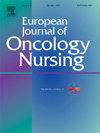Predictors of shared decision-making in patients with recurrent and metastatic nasopharyngeal carcinoma: An observational structural equation modeling approach
IF 2.7
3区 医学
Q1 NURSING
引用次数: 0
Abstract
Purpose
This investigation examines the interrelationships between SDM and key behavioral factors—decision-making attitude, self-efficacy, nurse-patient trust, and intention—among Chinese r/m NPC patients through structural equation modeling, guided by the Theory of Planned Behavior.
Methods
A cross-sectional investigation following STROBE guidelines. Through convenience sampling, 301 r/m NPC patients were enrolled from a Southern Chinese tertiary cancer center between November 2023 and June 2024. Participants completed comprehensive assessments including demographic data, the Decision Self-Efficacy Scale, Cancer Patients' Decision-Making Regarding Treatment Scale, Nurse-Patient Trust Scale, and Expectation of Involvement in Medical Decision-Making Scale.
Results
The mean score of SDM among patients with r/m NPC was 18.25 ± 6.29, indicating a low-middle level of SDM. Older age (β = 3.179) contributed to the low SDM level. The results of the structural equation model show that decision-making attitude (β = 0.254) and decision-making intention (β = −0.740) have direct effects on SDM. Furthermore, decision-making attitude (β = −0.453) and decision-making self-efficacy (β = 0.430) can indirectly influence SDM through the decision-making intention.
Conclusion
Healthcare professionals could utilize these pathway-specific findings to enhance shared decision-making implementation. Given the low-middle participation level, especially among elderly patients, healthcare providers should prioritize strategies that strengthen decision-making intention and foster positive participation attitudes. Future interventions should be tailored based on these identified pathways to effectively promote shared decision-making in clinical practice.
复发和转移性鼻咽癌患者共同决策的预测因素:一种观察性结构方程建模方法
目的在计划行为理论的指导下,通过结构方程模型,探讨中国r/m鼻咽癌患者SDM与决策态度、自我效能感、护患信任、意向等关键行为因素的相互关系。方法按照STROBE指南进行横断面调查。通过方便抽样,在2023年11月至2024年6月期间,从中国南方的一家三级肿瘤中心招募了301例NPC患者。参与者完成了包括人口统计数据、决策自我效能量表、癌症患者治疗决策量表、护患信任量表和参与医疗决策期望量表在内的综合评估。结果r/m鼻咽癌患者SDM平均评分为18.25±6.29,属于中低水平。年龄较大(β = 3.179)导致SDM水平较低。结构方程模型结果表明,决策态度(β = 0.254)和决策意图(β =−0.740)对SDM有直接影响。决策态度(β = - 0.453)和决策自我效能感(β = 0.430)可以通过决策意向间接影响SDM。结论医疗保健专业人员可以利用这些特定途径的发现来加强共同决策的实施。鉴于中低参与水平,特别是老年患者,医疗服务提供者应优先考虑增强决策意愿和培养积极参与态度的策略。未来的干预措施应根据这些确定的途径进行调整,以有效促进临床实践中的共同决策。
本文章由计算机程序翻译,如有差异,请以英文原文为准。
求助全文
约1分钟内获得全文
求助全文
来源期刊
CiteScore
4.40
自引率
3.60%
发文量
109
审稿时长
57 days
期刊介绍:
The European Journal of Oncology Nursing is an international journal which publishes research of direct relevance to patient care, nurse education, management and policy development. EJON is proud to be the official journal of the European Oncology Nursing Society.
The journal publishes the following types of papers:
• Original research articles
• Review articles

 求助内容:
求助内容: 应助结果提醒方式:
应助结果提醒方式:


